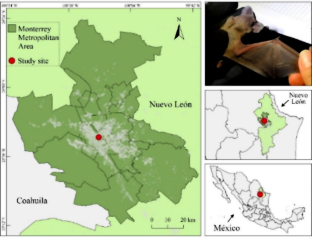Bulletin of Environmental Contamination and Toxicology ( IF 2.7 ) Pub Date : 2024-04-11 , DOI: 10.1007/s00128-024-03885-y Elva I. Cortés-Gutiérrez , Juan P. Ceyca-Contreras , Emma P. Gómez-Ruiz , Evelyn Rios , Catalina García-Vielma , Juan A. García-Salas

|
Environmental pollutants produce adverse effects on organisms and ecosystems. Biomonitoring and biomarkers offer a reasonable approach to make these assessments. Induced genetic changes can be using as a biomarker in organisms that react to a given compound in the ecosystem. Monitoring environmental genotoxicity necessitates the choice of model animals known as “sentinels or biological monitors” and the suitability of validated tests for DNA damage evaluation. We aimed to estimate the DNA damage produced by thermal stress in the leukocytes of the Mexican free-tailed bat (Tadarida brasiliensis). The DNA damage in bat leukocytes exposed to different temperatures (35 °C, 45 °C, and 55 °C) was evaluated by the adapted chromatin dispersion test (CDT) and the results were confirmed by the alkaline comet test. The CDT permitted a clear representation of leukocytes with fragmented DNA and of nonfragmented DNA. In addition, we detected nuclear anomalies in relation to cell death cellular swelling, nuclear fragmentation, and chromatin lysis. The alkaline comet assay revealed that the halos of diffuse chromatin include fragmented DNA. The assay of the method employing the CDT is well established, precise, and cost-effective for the routine quantitative analysis of DNA damage on the effect of the leukocytes of bats exposed to thermal stress. This could also apply as a sensitive screening tool for the evaluation of genotoxicity in environmental protection programs.
中文翻译:

使用染色质分散测试 (CDT) 检测蝙蝠血液白细胞中的 DNA 损伤:环境遗传毒性的生物标志物
环境污染物对生物体和生态系统产生不利影响。生物监测和生物标志物提供了进行这些评估的合理方法。诱导的遗传变化可以用作对生态系统中给定化合物做出反应的生物体的生物标志物。监测环境遗传毒性需要选择被称为“哨兵或生物监测器”的模型动物,以及经过验证的 DNA 损伤评估测试的适用性。我们的目的是评估热应激对墨西哥无尾蝙蝠 ( Tadarida brasiliensis )的白细胞造成的 DNA 损伤。通过适应性染色质分散试验(CDT)评估暴露于不同温度(35℃、45℃和55℃)的蝙蝠白细胞的DNA损伤,并通过碱性彗星试验证实结果。 CDT 可以清楚地表示具有片段化 DNA 和非片段化 DNA 的白细胞。此外,我们还检测到与细胞死亡、细胞肿胀、核碎片和染色质裂解相关的核异常。碱性彗星试验表明,弥漫性染色质的晕圈中含有片段化的 DNA。采用 CDT 的方法的测定是成熟、精确且具有成本效益的,可用于 DNA 损伤对暴露于热应激的蝙蝠白细胞影响的常规定量分析。这也可以用作评估环境保护计划中遗传毒性的敏感筛选工具。



























 京公网安备 11010802027423号
京公网安备 11010802027423号